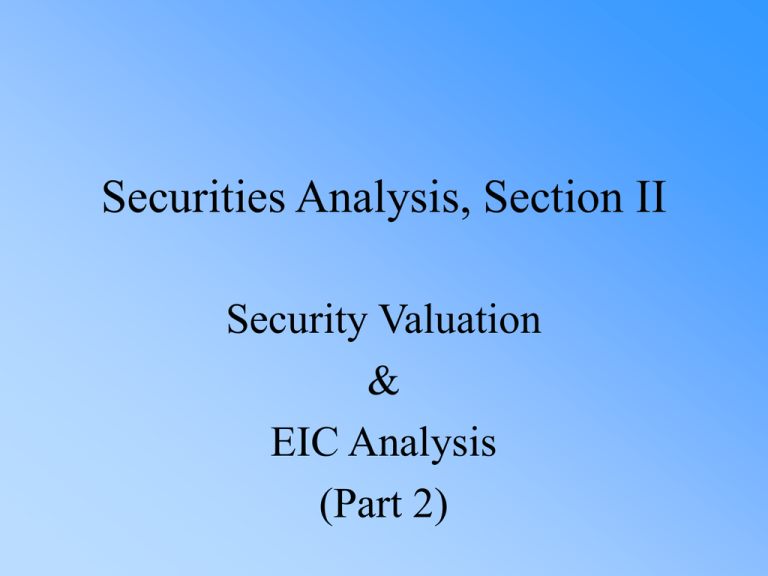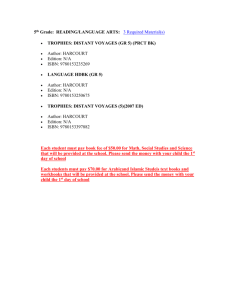
Securities Analysis, Section II
Security Valuation
&
EIC Analysis
(Part 2)
Lecture Presentation Software
to accompany
Investment Analysis and
Portfolio Management
Seventh Edition
by
Frank K. Reilly & Keith C. Brown
Chapters 11,14,15, & 18
Top-Down Approach, Step Two
• Industry Analysis
Copyright © 2000 by Harcourt, Inc. All rights reserved
Industry Performance
• Wide dispersion in rates of return in different
industries
• Performance varies from year to year
• Company performance varies within industries
• Risks vary widely across industries but are fairly
stable over time within industries
Copyright © 2000 by Harcourt, Inc. All rights reserved
Links Between the Economy
and Industry Sectors
• Economic trends are either
– Cyclical - up and down with business cycle
– Structural - major change
• Combined changes have implications for the
industry being analyzed
• Switching from one industry group to another over
the course of a business cycle is known as a
rotation strategy
– Identify and monitor key assumptions and variables
Copyright © 2000 by Harcourt, Inc. All rights reserved
The Stock Market and
the Business Cycle
Figure 19.2
Copyright © 2000 by Harcourt, Inc. All rights reserved
The Stock Market and
the Business Cycle
Figure 19.2
peak
trough
Copyright © 2000 by Harcourt, Inc. All rights reserved
The Stock Market and
the Business Cycle
Basic
Industries
Excel
Consumer
Durables
Excel
Financial
Stocks Excel
trough
peak
Capital
Goods Excel
Copyright © 2000 by Harcourt, Inc. All rights reserved
Figure 19.2
Consumer
Staples Excel
Cyclical Economic Factors
•
•
•
•
Inflation
Interest rates
International economics
Consumer sentiment
– All give clues about when to rotate
portfolio
Copyright © 2000 by Harcourt, Inc. All rights reserved
Structural Economic Changes
and Alternative Industries
• Social Influences
– Demographics
– Lifestyles
• Technology
• Politics and regulations
–
–
–
–
Economic reasoning
Fairness
Regulatory changes affect numerous industries
Regulations affect international commerce
Copyright © 2000 by Harcourt, Inc. All rights reserved
Theme Investing
• Based on identifying emerging trends, such as:
– Technology
– Aging population
– Freer trade and developing-country growth
• Identification of themes provides insight into
industry analysis
• Find a story to describe your vision of the future,
then invest in companies whose businesses are
consistent with that story
– Peter Lynch question – what is the story for your stock?
Copyright © 2000 by Harcourt, Inc. All rights reserved
Earnings and Valuation
• Valuation of company will depend upon its
earnings
• Earnings of company are dependent upon (and a
subset of) the earnings of the industry
• Level of earnings for the industry are a function
of:
– Industry sales
– Degree of competition within industry (impacts profit
margins – ability of company to realize profits from
sales)
Copyright © 2000 by Harcourt, Inc. All rights reserved
Earnings and Industry Analysis
• Estimating earnings per share
– start with forecasting sales per share
• Industrial life cycle
• Input-output analysis
• Industry-aggregate economy relationship
– earnings forecasting and analysis of industry
competition
•
•
•
•
•
competitive strategy
competitive environment
industry operating profit margin
industry earnings estimate
industry earnings multiplier
Copyright © 2000 by Harcourt, Inc. All rights reserved
Sales Forecasting and
Industry Life Cycle
• Pioneering development
• Rapidly accelerating industry
growth
• Mature industry growth
• Stabilization and market maturity
• Deceleration of growth and decline
Copyright © 2000 by Harcourt, Inc. All rights reserved
Sales Forecasting and
Input-Output Analysis
• Identify suppliers and customers
• Future demand from customers
• Ability of suppliers to provide goods
and services required
• Extended to global industries, include
worldwide suppliers and customers
Copyright © 2000 by Harcourt, Inc. All rights reserved
Sales Forecasting and
the Industry-Economy Relationship
• Compare industry sales to aggregate
economic series related to the goods
and services provided by the industry
Copyright © 2000 by Harcourt, Inc. All rights reserved
Forecasting Earnings Per Share
• Analysis of industry competition
• Analysis of competitive structure
• Porter’s concept of competitive
strategy
Copyright © 2000 by Harcourt, Inc. All rights reserved
Competitive Structure of an
Industry
• Porter’s Competitive Forces
– Rivalry among existing competitors
– Threat of new entrants
– Threat of substitute products
– Bargaining power of buyers
– Bargaining power of suppliers
Copyright © 2000 by Harcourt, Inc. All rights reserved
Top-Down Approach, Step Three
• Company and Stock Analysis
Copyright © 2000 by Harcourt, Inc. All rights reserved
Company Analysis and Stock Selection
• After analyzing the economy and stock markets
for several countries you have decided to invest
some portion of your portfolio in common stocks
• After analyzing various industries, you have
identified those industries that appear to offer
above-average risk-adjusted performance over
your investment horizon
• Which are the best companies?
• Are they overpriced?
Copyright © 2000 by Harcourt, Inc. All rights reserved
Company Analysis and Stock Selection
• Good companies are not necessarily good
investments
• Compare the intrinsic value of a stock to its
market value
• Stock of a great company may be overpriced
• Stock of a growth company may not be growth
stock
Copyright © 2000 by Harcourt, Inc. All rights reserved
Types of Companies and Stocks
•
•
•
•
Growth
Defensive
Cyclical
Speculative
Copyright © 2000 by Harcourt, Inc. All rights reserved
Growth Companies
• Growth companies have historically been
defined as companies that consistently
experience above-average increases in sales
and earnings
• Financial theorists define a growth company
as one with management and opportunities
that yield rates of return greater than the
firm’s required rate of return
Copyright © 2000 by Harcourt, Inc. All rights reserved
Growth Stocks
• Growth stocks are not necessarily shares in
growth companies
• A growth stock has a higher rate of return
than other stocks with similar risk
• Superior risk-adjusted rate of return occurs
because of market undervaluation compared
to other stocks
Copyright © 2000 by Harcourt, Inc. All rights reserved
Value versus Growth Investing
• Growth stocks will have positive
earnings surprises and above-average
risk adjusted rates of return because the
stocks are undervalued
• Value stocks appear to be undervalued
for reasons besides earnings growth
potential
• Value stocks usually have low P/E ratio
or low ratios of price to book value
Copyright © 2000 by Harcourt, Inc. All rights reserved
Value versus Growth Investing
• Buffett’s view:
– Growth is a key determinant of value for any stock, so it is
always a component of determining whether or not a stock is
undervalued
– Furthermore, so long as the market is under-valuing a stock,
then he would categorize it as a “value” stock
– Finally, he considers all investing to be “value” investing
– Thus, he considers “value” vs. “growth” investing to be a false
dichotomy
– Buffett’s approach could be categorized as a GARP approach
to investing
Copyright © 2000 by Harcourt, Inc. All rights reserved
Defensive Companies and Stocks
• Defensive companies’ future earnings are
more likely to withstand an economic
downturn
• Low business risk
• Not excessive financial risk
• Stocks with low or negative systematic risk
Copyright © 2000 by Harcourt, Inc. All rights reserved
Cyclical Companies and Stocks
• Sales and earnings heavily influenced by
aggregate business activity
• Stocks with high betas
Copyright © 2000 by Harcourt, Inc. All rights reserved
Speculative Companies and Stocks
• Assets involve great risk
– e.g., biotechs, bankruptcies, etc.
• Can be viewed as a gamble
– Possible great gain
– Stock may be overpriced
Copyright © 2000 by Harcourt, Inc. All rights reserved
Economic, Industry, and Structural
Links to Company Analysis
• Company analysis is the final step in the topdown approach to investing
• Macroeconomic analysis identifies industries
expected to offer attractive returns in the
expected future environment
• Analysis of firms in selected industries
concentrates on a stock’s intrinsic value
based on growth and risk
Copyright © 2000 by Harcourt, Inc. All rights reserved
Economic and Industry Influences
• If trends are favorable for an industry, the
company analysis should focus on firms in that
industry that are positioned to benefit from the
economic trends
• Firms with sales or earnings particularly sensitive
to macroeconomic variables should also be
considered
• Research analysts need to be familiar with the
cash flow and risk of the firms
Copyright © 2000 by Harcourt, Inc. All rights reserved
Structural Influences
• Social trends, technology, political, and
regulatory influences can have significant
influence on firms
• Early stages in an industry’s life cycle see
changes in technology that followers may
imitate and benefit from
• Politics and regulatory events can create
opportunities even when economic
influences are weak
Copyright © 2000 by Harcourt, Inc. All rights reserved
Company Analysis
•
•
•
•
Industry competitive environment
SWOT analysis
Present value of cash flows
Relative valuation ratio techniques
Copyright © 2000 by Harcourt, Inc. All rights reserved
Firm Competitive Strategies
•
•
•
•
•
Current rivalry
Threat of new entrants
Potential substitutes
Bargaining power of suppliers
Bargaining power of buyers
Copyright © 2000 by Harcourt, Inc. All rights reserved
Firm Competitive Strategies
• Defensive or offensive
• Defensive strategy deflects competitive
forces in the industry
• Offensive competitive strategy affects
competitive force in the industry to
improve the firm’s relative position
• Porter suggests two major strategies: lowcost leadership and differentiation
Copyright © 2000 by Harcourt, Inc. All rights reserved
Low-Cost Strategy
• Seeks to be the low cost leader in its
industry
– Through economies of scale (in production or
marketing), better logistics, etc.
• Must still command prices near industry
average, so still must differentiate
• Discounting too much erodes superior
rates of return
Copyright © 2000 by Harcourt, Inc. All rights reserved
Differentiation Strategy
• Identify as unique in its industry in
an area that is important to buyers
• Above average rate of return only
comes if the price premium
exceeds the extra cost of being
unique
Copyright © 2000 by Harcourt, Inc. All rights reserved
Focusing a Strategy
• Select segments in the industry
• Tailor strategy to serve those specific
groups
• Determine which strategy a firm is
pursuing and its success
• Evaluate the firm’s competitive
strategy over time
Copyright © 2000 by Harcourt, Inc. All rights reserved
SWOT Analysis
• Examination of a firm’s:
– Strengths
– Weaknesses
– Opportunities
– Threats
Copyright © 2000 by Harcourt, Inc. All rights reserved
SWOT Analysis
• Examination of a firm’s:
– Strengths
– Weaknesses
– Opportunities
– Threats
INTERNAL ANALYSIS
Copyright © 2000 by Harcourt, Inc. All rights reserved
SWOT Analysis
• Examination of a firm’s:
– Strengths
– Weaknesses
– Opportunities
– Threats
EXTERNAL ANALYSIS
Copyright © 2000 by Harcourt, Inc. All rights reserved
Lynch’s Favorable Attributes
1. Firm’s product is not faddish
2. Company has competitive advantage over
rivals
3. Industry or product has potential for market
stability
4. Firm can benefit from cost reductions
5. Firm is buying back its own shares or
managers (insiders) are buying
Copyright © 2000 by Harcourt, Inc. All rights reserved
Lynch’s Categories of Companies
1. Slow growers
2. Stalwart
3. Fast growers
4. Cyclicals
5. Turnarounds
6. Asset plays
Copyright © 2000 by Harcourt, Inc. All rights reserved
Company and Common Stock Valuation
• General models for valuation discussed in
previous set of lecture notes.
• But, where do you get the inputs for these
models?
• Sources for inputs, checking your figures,
and some specific-purpose extensions of the
models discussed next.
Copyright © 2000 by Harcourt, Inc. All rights reserved
Estimating the Inputs: The Required Rate of
Return and The Expected Growth Rate of
Valuation Variables
Valuation procedure is the same for securities
around the world, but the required rate of
return (k) and expected growth rate of
earnings and other valuation variables (g)
such as book value, cash flow, and dividends
differ among countries
Copyright © 2000 by Harcourt, Inc. All rights reserved
Required Rate of Return (k)
• Required rate of return on equity (ke) affects
valuation, regardless of approach:
– kV , and vice versa
• This required rate of return will be used as the
discount rate and also affects relative-valuation
• Although ke is not directly used in the present
value of operating cash flow approach, it is
nonetheless a component of WACC
Copyright © 2000 by Harcourt, Inc. All rights reserved
Required Rate of Return (k)
• But, what is the proper approach for
deriving ke?
– CAPM?
– APT?
– Haugen’s ad hoc expected return factor model?
• Still an open question
– CAPM most widely used in practice
– Even then, questions can remain in terms of
how to apply the model
Copyright © 2000 by Harcourt, Inc. All rights reserved
Estimating Growth Rates
Three general approaches:
1. Reinvestment-rate approaches
–
Sustainable Growth Rate = RR X ROE
2. Historical estimates
–
–
Point estimates of growth rates
Regression-based estimates of growth rates
3. Back out growth rates from estimated size of
future market
–
Compare company to industry (Ch. 20) and industry
to economy as a whole (Ch. 19)
Copyright © 2000 by Harcourt, Inc. All rights reserved
Expected Growth Rate of Dividends
• Determined by
– the growth of earnings
– the proportion of earnings paid in dividends
• In the short run, dividends can grow at a different
rate than earnings due to changes in the payout
ratio
• Earnings growth is also affected by compounding
of earnings retention
g = (Retention Rate) x (Return on Equity)
= RR x ROE
Copyright © 2000 by Harcourt, Inc. All rights reserved
DuPont Breakdown of ROE
ROE
Net Income
Sales
Total Assets
Sales
Total Assets Common Equity
=
Profit
Margin
Total Asset
x Turnover
Financial
x Leverage
Copyright © 2000 by Harcourt, Inc. All rights reserved
Estimating Growth Based on History
•
•
•
Alternative to reinvestment rate approach
Historical growth rates of sales, earnings, cash
flow, and dividends
Two general techniques
1. arithmetic or geometric average of annual
percentage changes (point estimates)
2. linear or log-linear regression models
•
Both use time-series plot of data
Copyright © 2000 by Harcourt, Inc. All rights reserved
Checking Your Figures:
Three Alternative Measures of Value
(cf., Value Investing)
1. Value of Company’s Assets
–
–
–
Graham & Dodd net-net approach
Book Value of Assets – P/BV for valuation
Market value / replacement value of assets
2. Earnings Power Value
–
–
–
Value company’s current earnings, adjusted for seasonality /
cyclicality – DCF value assuming growth = 0 or = long-run
growth in economy
Greater than value of company’s underlying assets iff
company holds competitive advantage or benefits from
barriers to entry
Understanding value requires knowledge of industry
Copyright © 2000 by Harcourt, Inc. All rights reserved
Checking Your Figures:
Three Alternative Measures of Value
(cf., Value Investing)
3. What is Growth Worth?
–
Adds value only if growth occurs “within the franchise”
•
•
•
•
Potential problem - firm retains earnings, but reinvestment returns
are below the firm’s cost of capital (i.e., project NPV is negative)
Taking on more projects means that sales and earnings will grow,
but not by enough to cover additional costs of capital, so growth
will actually destroy value held by current shareholders
Key lesson = not all growth is “value-adding”
Only projects with positive NPV’s will create value, and projects
will only have positive NPV if they exploit or occur within the
firm’s realm of competitive advantage, i.e., within the firm’s
franchise
Copyright © 2000 by Harcourt, Inc. All rights reserved
Analysis of Growth Companies
• Generating rates of return greater than the firm’s
cost of capital is considered to be temporary
• Earnings higher than the required rate of return are
pure profits
• How long can they earn these excess profits?
• How long are they likely to earn these excess
profits?
• How long does the market expect them to earn
these excess profits?
• Is the stock properly valued?
Copyright © 2000 by Harcourt, Inc. All rights reserved
Measures of Value-Added
• The Franchise Factor
– Breaks P/E into two components
• P/E based on ongoing business (base P/E)
• Franchise P/E the market assigns to the expected value of
new and profitable business opportunities
Franchise P/E = Observed P/E - Base P/E
Incremental Franchise P/E = Franchise Factor X Growth Factor
Rk
G
rk
Copyright © 2000 by Harcourt, Inc. All rights reserved
Growth Duration
• Evaluate the high P/E ratio by relating P/E ratio to
the firm’s rate and duration of growth
• P/E is function of
– expected rate of growth of earnings per share
– stock’s required rate of return
– firm’s dividend-payout ratio
• Use the ratio of P/E’s, related to growth and
dividend rates, to infer the market’s implied
growth duration:
Copyright © 2000 by Harcourt, Inc. All rights reserved
Intra-Industry Analysis
• Directly compare two firms in the same industry
• An alternative use of T to determine a reasonable
P/E ratio
• Factors to consider
– A major difference in the risk involved
– Inaccurate growth estimates
– Stock with a low P/E relative to its growth rate
is undervalued
– Stock with high P/E and a low growth rate is
overvalued
Copyright © 2000 by Harcourt, Inc. All rights reserved
Growth Duration
T
(1 G g D g )
Pg (0)/E g (0)
T
PB 0 / E B (0) (1 G B D B )
Pg (0)/E g (0)
1 G g Dg
T ln
ln
PB 0 / E B (0)
1 G B DB
P/E g
ln
P/E B
T
1 G g Dg
ln
1 G B DB
Copyright © 2000 by Harcourt, Inc. All rights reserved
Growth Duration
Alternatively, the equation can be rearranged to determine a
justified P/E ratio for a firm, given its expected dividend yield and
growth rate and the expected length of time over which the firm will
continue to experience above-average growth, relative to its
benchmark (B).
1 G g Dg
P/E g P/E B
1 G B DB
Copyright © 2000 by Harcourt, Inc. All rights reserved
T
Extensions on Growth Duration
• For more information and additional
extensions and applications in using marketbased information to infer the market’s
assumptions about the various factors that
drive a stock’s valuation, see:
– www.expectationsinvesting.com
Copyright © 2000 by Harcourt, Inc. All rights reserved
When to Sell
• Knowing when to sell is an even harder decision
than knowing when to buy
– Holding a stock too long may lead to lower returns than
expected
– If stocks decline right after purchase, is that a further
buying opportunity or an indication of incorrect analysis?
– Continuously monitor key assumptions
– Evaluate closely when market value approaches estimated
intrinsic value
– Know why you bought it and watch for that to change
– Always need a “sell discipline”
Copyright © 2000 by Harcourt, Inc. All rights reserved
Efficient Markets
• Opportunities are mostly among less well-known
companies
• To outperform the market you must find disparities
between stock values and market prices - and you must
be correct
• Concentrate on identifying what is wrong with the
market consensus and what earning surprises may exist
– Again, useful to examine the expectations that underlie the
current market price
– Are these realistic/optimistic/pessimistic?
Copyright © 2000 by Harcourt, Inc. All rights reserved
Next Up:
Final Topic
• Topics in Bond Analysis
• Are the Markets Rational?
Copyright © 2000 by Harcourt, Inc. All rights reserved
Copyright © 2000 by Harcourt, Inc. All rights reserved








